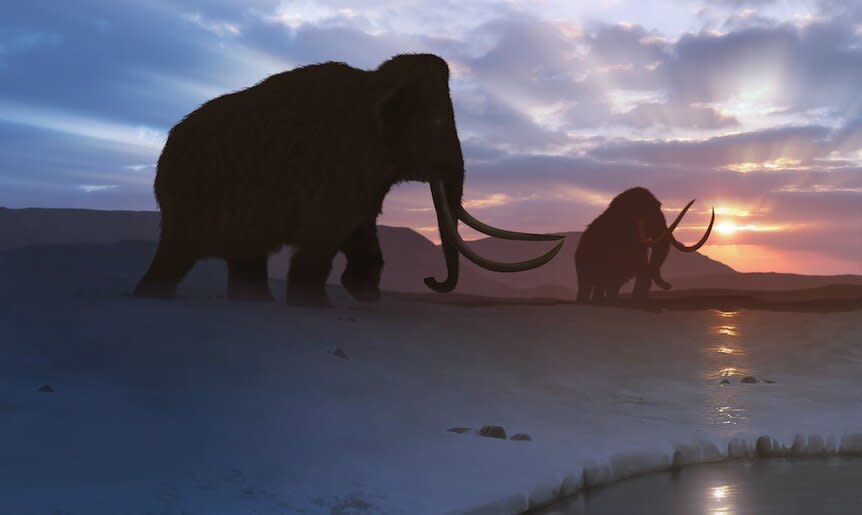Colossal Genetic Breakthrough Could Be the Key to Reviving Wooly Mammoths

- Oops!Something went wrong.Please try again later.
- Oops!Something went wrong.Please try again later.
When Michael Crichton was working on the book that would become Jurassic Park, he found inspiration in paleobiologist George Poinar’s work on the cellular preservation of specimens in amber. Poinar found that a fly stuck in amber had its intracellular structures (nucleus and other organelles) preserved even after 40 million years. From there, it was a brief narrative step to mosquitoes and dino DNA.
Unfortunately, in the real world DNA doesn’t stick around for 66+ million years, even inside amber. If we ever do resurrect dinosaurs, it’s unlikely that will be our method. In fact, the practice of de-extinction might be limited to species which were lost more recently. Back in 2016, while speaking to NPR’s Science Friday, Poinar said, “I don’t think it’s possible to bring a dinosaur back from what we have; I’ll leave that to the books and the movies. Today, bringing back ancient animals is based more on Pleistocene remains like bones, because they’re not so old and easier to get DNA out of.”
A real-life Jurassic Park probably isn’t in the cards for us, but a Pleistocene Park made up of animals who lived 2.58 million to a few thousand years ago, might be possible, thanks to well-preserved Pleistocene specimens. Wooly mammoths are of particular interest because they trundled across Siberia’s permafrost where their remains could be freeze dried for thousands of years. Back in 2022, researchers found a baby mammoth in Canada’s Yukon, almost perfectly preserved after 30,000 years. We’ve got good ingredients to work with, we just need to figure out the recipe for cooking a fresh mammoth in the lab.
Enter Colossal Biosciences, the de-extinction company making headlines for their promise to bring back the Tasmanian tiger, the dodo, and the wooly mammoth. On that last front, Colossal recently took a mammoth-sized step. Colossal scientists have succeeded at creating induced pluripotent stem cells from the Asian elephant for the very first time. The research was posted to the preprint server bioRxiv and has not yet been peer reviewed, though that process is in progress, the company says.
For More on Mammoths (and Other Prehistoric Animals):
30,000-Year-Old Mummified Baby Mammoth Found in Canada’s Yukon Permafrost
Mammoth Find: The Oldest DNA Ever Sequenced Comes from Ancient Mystery Mammoth
Wooly Rhino Genome Recovered from Fossilized Hyena Poop
Reviving the Wooly Mammoth

Photo: MARK GARLICK/SCIENCE PHOTO LIBRARY/Getty Images
Wooly mammoths are an extinct member of the elephant family, noted for their long, curved tusks, thick wooly coat, and icy stomping grounds. They first showed up about 6 million years ago and spread across Siberia and North America before disappearing a few thousand years ago, well within human memory. In fact, mammoths make appearances in some of our earliest art, and we find their bones in ancient tools and jewelry, the obvious victims of human hunters.
As the last glacial period came to an end, their frigid terrain shrank, pushing them into smaller and smaller areas. That last isolated population went extinct on Russia's Wrangel Island about 4,000 years ago. The loss of their habitat combined with the increasing threat of human hunters pushed them to the brink, then beyond it. Of course, mammoths weren’t the only victims, they were just one of the species lost during a great megafauna extinction at the end of the Pleistocene.
Bringing them back after a 4,000-year absence would be good evidence that there’s a grace period on extinction. The headline grabbing announcement that Colossal has made progress on the mammoth resurrection project might be good for the mammoth but it’s got an even better shot of being good for elephants. Bringing back an extinct species, let alone several, requires the development of new tools and scientific breakthroughs like this one which have uses and applications supporting threatened species that aren’t extinct yet.
Colossal Biosciences Creates First Elephant Induced Pluripotent Stem Cells

Mr. DNA from Jurassic Park Photo: Universal Pictures
Induced pluripotent stem cells (iPSCs) usually start out as skin or blood cells. Scientists tinker with them, coaxing them into reverting to an embryonic state. Once they’ve regressed, iPSCs can become any type of cell you might want. You can make them become muscle cells or brain cells, maybe even sperm cells and egg cells.
In the meantime, Colossal researchers can use iPSCs to study the traits that made wooly mammoths good at living in the cold. They can also be used to study the traits of living elephants and find better ways to manage their populations and conservation.
“This milestone gives us insights into developmental biology and the balance between senescence and cancer. It opens the door for obtaining gametes and other cell types without surgery on precious animals, said Colossal co-founder and geneticist Dr. George Church, in a statement. “It opens the door to establishing connections between genes and traits for both modern and extinct relatives – including resistance to environmental extremes and pathogens.”
Living elephants might benefit from the research through better treatments or genetic resistance against diseases like elephant endotheliotropic herpesviruses, which is fatal in almost two-thirds of cases. And that could happen whether or not a neo-mammoth ever walks the Earth. If we do bring them back, here’s hoping we figure out how to live together this time.
Catch the science fiction classic Jurassic Park, available from Universal Pictures.

